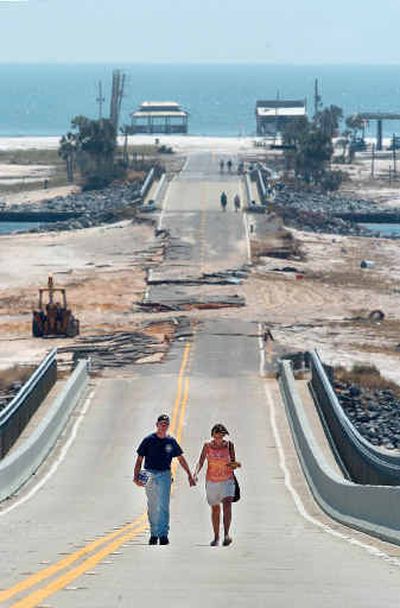Ivan’s grim aftermath

PENSACOLA, Fla. – Jim Hegman’s entire fortune and future were tied up in his home: a 37-foot sailboat he restored with his own hands and lived in off the shores of Pensacola.
If a man’s house is his castle, Hegman’s Tayana 37 was a floating palace – its gleaming teakwood deck sanded and shined, a kitchen cabinet he built over the sink below, a tower he constructed for the radar and wind generator.
Where other men carry photos of wives and kids in their wallets, Hegman displays one of his boat. “It used to be a beautiful thing,” he said, standing before the ruins of his home, left with only a pickup truck bed to sleep in and a few diesel-soaked tokens of the past.
“What do you move on to?” the 50-year-old sailor asked.
Three days after Ivan cut a path of destruction across the Gulf Coast, thousands were struggling with the same question.
There are the tangible losses: No water for showers. No power for cooking. No gas to get around.
And there is something far less visible but just as palpable: the uncertainty of what comes next and how to begin starting over.
After Ivan roared ashore along the Gulf Coast early Thursday with 130 mph wind, tornadoes and towering waves, it cut a path of destruction across the South and Northeast that left 44 people dead, 16 of them in Florida. Earlier, it was blamed for 70 deaths in the Caribbean.
Hundreds of urban search and rescue workers scoured demolished neighborhoods, some using tracking dogs to look for victims in the rubble and along flooded riverbanks.
More than a million people were without power across 13 states, including more than 340,000 homes and businesses in Florida, state officials said Saturday.
The business of rebuilding was under way in earnest on Saturday. Road crews worked furiously to bulldoze debris to the side of byways in Florida, while several major thoroughfares – including a buckled interstate bridge – stayed closed to travelers. Other streets remained an obstacle course of tree limbs and power lines.
Utility workers managed to restore a major generating plant and some 150 miles of transmission lines, but “there is still an unbelievable amount of hot, hard and dangerous work ahead,” Gulf Power spokesman John Hutchinson said.
Even before sunup, thousands lined up at a Pensacola shopping center where Florida National Guard members distributed meals-ready-to-eat, water and ice from semitrucks. Cars stretched for miles on one side of the parking lot. On the other, hundreds of people – including pregnant women and young kids – waited on foot for supplies.
With Ivan the third hurricane to strike the state in a matter of weeks, Panhandle residents joined their neighbors to the south in learning to cope with the aftermath of disaster.
“I think the biggest problem that Florida is going to face is fatigue,” FEMA director Michael Brown said Saturday. “When you think about these three hurricanes, the continuing rains and storms, and just the heat, people are going to get worn out.”
Some folks juggled cleanup projects, working on what was left of their own homes before heading to a relative’s or neighbor’s to lend a hand. Even those who escaped the storm unscathed fought back frustration as life as they knew it ground to a halt.
“It doesn’t matter that we didn’t get damage. With no power, we can’t work,” grumbled 35-year-old Tim Vann, who owns a tanning salon in Pensacola. “You’ve got no power. You’ve got no fridge. You lay in bed in the heat.
“There’s only one thing you can do,” Vann said, “try to relax.”